#i have a few designs for the gods that differ because gods are often reinterpreted many times over
Explore tagged Tumblr posts
Text
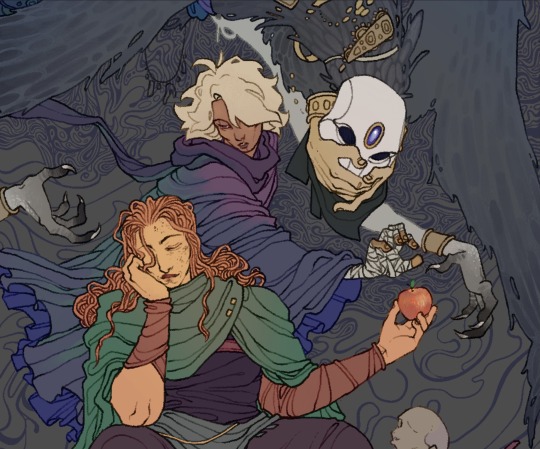
wip. i REALLY want to finish this. therion my baby my love. he is so me
#darius octopath#therion octopath#also that figure is aeber#prince of thieves#i have headcanons#i have a few designs for the gods that differ because gods are often reinterpreted many times over#if i designed the same god for both games id defo have them look different#but in my head dohter is a river spirit#meow#purr etc#fanart#8path#octopath 2#obsidian_portfolio
80 notes
·
View notes
Text
Viola Bonaldi interviews Bobby BeauSoleil
This is the raw interview Viola Bonaldi did with Bobby BeauSoleil in the summer of 2018. Viola Bonaldi wrote an article incorporating the raw material below for Salmuria.
You can read the English version here: https://salmuria.it/emailing-with-bobby-beausoleil/
… Or if your first language happens to be Italian, read it here: https://salmuria.it/corrispondenza-con-bobby-beausoleil/
How did your passion for art — first music and then visual art — come about? Do you remember a specific moment or an episode that enlightened you? Did the Sixties atmosphere play an important role?
As far as I can tell, I mean, to the best of my recollection, I already had a passion to express myself in creative ways when I was born. According to what my mother told me later, about the time I took my first steps I was playing her pots and pans and making drawings on the walls of the house.
Honestly, I can’t remember a time when I didn’t feel like I had something to say in the arts. I believe this is the case with most if not all artists. For some a passionate desire to express in the arts may lay dormant for a time, and then suddenly something happens that triggers the calling, awakening the latent artist within. In my case it seems that I was born turned on. I didn’t need the social explosion that happened in the 1960s to bring the creative urges out of me, but it did provide a playground for them, and sometimes I found inspiration in the passions of people I encountered during that period.
When you haunted the Sunset Strip in Los Angeles you were known as “Cupid”, the archaic Roman primordial god of love, because of the way girls liked to be around you, a young, vibrant, beautiful, multicolored artist. From that capricious god you eventually turned yourself into “Lucifer”, the “angel of light”, fallen from Paradise as a consequence of his pride. Your life is largely connected to archaic myths, and this is often reflected in your work as an artist, both musically and visually, which is full of esoteric symbolism. Now, more than four decades after your work on Lucifer Rising, who are you? Lucifer, Cupid, or some other “creature”? And how do you explain your interest in the arcane?
Wow! Big questions! Well, first of all, I have never pretended to actually be any “creature”, as you put it, that I’ve been associated with. I am just me, an innately nameless soul. As an artist, I have sometimes used my own physical being as a canvas, willingly adopting personas from mythology that others have seen in me. My parents gave me a name at birth and I have been happy to be that person most of the time. Occasionally I have taken on the personifications of archetypes from myth as a way of allowing them to live for a brief time, and in a limited way, in the world of the mundane. There are, by the way, some common traits between Cupid and Lucifer. Both of these mythological beings are imagined as angelic, both known to have a naughty streak, to be creatively rebellious, and both are associated with love. I can think of far worse things to be known for expressing in the world.
What attracts me to the myths is the wealth of story and allegory that can enrich our larger capacity for understanding. Myths are often used as a tool for deepening cultural identity, and to give a hand up by way of providing context and instruction to those who aspire to higher truths. And mythology is an artform that can inspire new art, and thus myths can be alive and continue to grow and influence. As for other arcane interests, I have found little of any real substance in the so-called “dark arts” or silly practices like devil worship. However, as a mystic seeker I have found that treasures are often hidden in dark places. Following a shadow to its source will invariably lead one to the light.
You write that your works are rarely borne out of direct observations of the natural world, from the perception of real things, but come instead from your own mental reinterpretations and from the world of dreams. Is this a consequence of your limited conditions in terms of the space you live it? What is your process for drawing subjects from your recurrent dreams?
Certainly, there are no beautiful vistas to be seen through the dirty windows of the place where I live. I can see moving images from nature in photographs and films, and sometimes these inspire me to produce a visual interpretation. For the most part, though, I tend to see the beauty of nature as paintings made by God, ever changing in the light of consciousness, awesomely inspired and breathtaking, far beyond the capabilities of any human artist to do them justice. Rather than producing poor imitations of the moving paintings created by God, my natural inclination is to make a few humble additions to God’s creation, as one of the forces of nature.
So, for the most part, I draw inspiration from my unfettered and fertile imagination. You can fly in your dreams, right? What can be seen, imagined or experienced is not limited to what is possible in the physical world in some states of mind. I cultivate some of these states of mind, such as lucid dreaming, as a source for concepts that may be made manifest in the physical world through my arts. This works for visual imagery and for music as well, and even sometimes for written words, like poetry. In the vast territories of dreams especially — both daydreams and the kind that happen during sleep — the mind plays freely, in safety, amorphously creating odd mash-ups, evolving patterns, astonishingly wonderous sounds. Much of my work is an attempt to bring these experiences into the physical realm, or at least to hint at them.
What does a young man think when he is sent to death row? You couldn’t play an instrument or have contact with other people, right?
When I arrived on San Quentin’s death row in 1970 I was a total wreck, broken and shattered, far more devastated than I ever let anyone know during that period. As difficult as it was, in some ways that 26 months I was on death row was a blessing. I needed that time alone to grapple with my conscience, to fully face what I had done head-on, to begin to learn how to think things through and begin the process of accepting responsibility for how I was going to deal with the consequences of my actions and eventually find a way to redeem myself. It was a tall order, one that seemed utterly insurmountable at the time. Think of a complicated picture-puzzle with about a million pieces.
Having a guitar was not allowed on death row, like you say, but I could get a little manual typewriter and a few pencils and sketch paper. Writing and drawing helped me to focus on my inner world and begin the process of putting the pieces of myself back together.
Where did you learn to create musical instruments? How did you manage to do that in prison?
Finding ways of making new or different kinds of sounds has been a fascination for me since I was a small boy. The first time I built a musical instrument was when I was about 8 years old. It was a contraption I called a “jazz band” — basically a percussion instrument made out of a wooden crate, with a variety of found objects like tin cans, pie plates, glass jars, spoons and whatnot nailed or attached to the crate in some way. I made a lot of noise on that thing, beating on it with sticks. A couple of years later I made an electric guitar — or rather, something that looked like a guitar I had seen in the window of a music store — in the workshop class at my school. It didn’t work, but from that experience I learned a lot about what is needed to make one that would. I have customized, or “hot-rodded”, every guitar I’ve had since, and built a few guitars from scratch.
In the mid-1960s, when I was putting together a band that would become known as The Orkustra, I was faced with the challenge of figuring out how to go about electrically amplifying different kinds of woodwinds and stringed instruments. This was a necessary step in fulfilling my desire to assemble the first electric orchestra. This experience became invaluable ten years later when I took on the Lucifer Rising soundtrack project. After I was given a permission from the warden at the prison to produce recordings for the project I successfully sought an additional permission to build some of the instruments I would need in the prison handicraft shop. I was allowed to build several guitars and keyboard instruments, and to experiment with music electronics and synthesizer design. This led to the invention and development of some instrument innovations.
Things have changed in prisons since then, with most of the prison handicraft programs having been shut down. Though I’m not able to build instruments at present, I still manage to find ways to hot-rod guitars. Fortunately, the technical skills I acquired earlier opened doors to my being in prison jobs that have given me access to advanced tools for producing work in various media, including video and sound design. I have been blessed with some unusual opportunities to employ my abilities in ways that are helpful and beneficial to others. Despite the imprisonment, I count myself fortunate to have had these opportunities, and I am grateful.
How can a human being detained for decades in prison survive in such a place without becoming a “monster”, as you have reflected in some of your writings? Can we say that Lucifer Rising saved you?
Prisons are unnatural places. They are ill-conceived responses to social problems like crime and mental illness — and in the US, anyone who breaks a law, mentally ill or not, is subject to incarceration in the prison system. In practice, imprisonment worsens these types of problems, generally speaking. Imprisonment warps the mind, not only of prisoners but also of the people who are paid to supervise them and keep them locked in.
Fairly early in my incarceration I became aware of the effects being in prison was having on me, and on others around me. By that time, I had already begun to slip into involvement in violent situations. When I saw what was happening I began to take steps to mitigate those negative effects. I resolved that I would never allow the prison environment to define me. Making a personal vow of non-violence that I have maintained to this day was one of those steps. By pouring myself into creative expression as an artist, along with promoting and maintaining healthy relationships with people on the outside, I have been able to gird myself against the insanity around me. It takes continuous effort and resolve, and a lot of vigilance, but it is possible to empower oneself to rise above the snares and pitfalls of prison life and maintain one’s personal integrity.
Yes, you could say that the Lucifer Rising soundtrack project saved me, in a way. It took years to complete the soundtrack compositions and recordings. During that time the project consumed me utterly. And it did so in a positive way. My concept for the Lucifer Rising themes was to musically describe the fallen angel’s desire to redeem himself, tracing his path through the dark passages he would pass through in his journey toward reconciliation and the light. The story, as I decided to interpret it, has certain resonances in my own life, so working on the project was cathartic.
Did you like Charles Manson’s music?
Sometimes I did and sometimes I didn’t. Charlie was a uniquely talented musician, but he had a tendency to be inconsistent in the way he approached musical performance. Much of this had to do with context. Some of his songs were a lot like songs for children, and were obviously meant to be sing-along songs for the people in his commune. Those songs would not have had much appeal to a general audience, and I have seen them used in sensationalist media to ridicule his musical ability. There were songs of Charlie’s that would not stand the tests of time, like much of the music that was made during the sixties, but many of his songs were entirely relevant for that period and some of them had real depth of meaning. The ones I liked best were those that he sang and played spontaneously, in a stream-of-consciousness style, like some rappers of today. As an improvisational player, I particularly enjoyed playing with him on songs he created in this mode. My accompaniment seemed to inspire him and helped to bring out the best qualities in his performances. This type of collaboration formed the basis of my relationship with him, such as it was. Unfortunately, no good recordings have survived.
You appear to have a deeply spiritual conception about purpose in relation to destiny. You have written that every person is born with some special ability or message they are meant to express in the world, a unique hand of cards to play in life. If you had not done “a bad thing” as your Professor Proponderus character said in the animated film you made, and been sent to prison, what do you think your life would have been like? Who would Bobby Beausoleil have become outside of jail? How would he have played his cards?
Taking my cue from the cards metaphor seems like the best place to begin a response to your questions ... The thing is, most human beings are not dealt only one hand of cards in life. Each time one makes a major decision in life, or has a significant accident, Destiny deals the individual a new hand of cards to play. It is impossible to say what my life might have been like had I not made the dire decisions that caused me to be sent to prison.
Some imaginative writers have postulated that each major decision creates a new timestream in a parallel universe. Well, I don’t know if that’s true, and it’s doubtful any of us ever will in our lifetimes, but let’s play along for the sake of giving due respect to what you are asking. Had I played my hand of cards differently in 1969 it’s conceivable that the Bobby Beausoleil of that alternate universe would have become a famous rock star, as I once hoped to be. Just as conceivable, the Bobby Beausoleil of another parallel universe might have wound up in some dark alley, dead of a drug overdose, something I have never had any aspirations to be.
We don’t get to choose beyond playing the cards we are dealt as well as we can in the hope that our decisions will take us to where we want to go. It is when we play our cards willy-nilly, without care, that we may instigate disasters in our lives and the lives of others. That said, I have done my best to play my cards well in the intervening years, and to overcome, to the extent that may be possible, the failings of my past. We shall see what the cards I play now will bring in the future.
Reading the transcript from your last parole hearing one can note that your artistic activity, and publishing communications with people outside of prison via the internet, has sometimes been used against you and your release. But you still do it. Do you do this out of a philosophical sense of duty, or because you feel safer in prison and don’t really want to be released? I mean, it seems like you’re shooting yourself in the foot ...My idea is that it’s only an excuse. It doesn’t matter what you do. For some people you will always be condemned because you have the Manson stigma on you.
Excuses are made by people who shirk the responsibilities they have agreed to accept, and who fail to have the courage to do the right thing and uphold those responsibilities. After long and very careful consideration, I resolved years ago that I would not restrict or limit my life in accordance with the excuses made by other people.
This is not an act of defiance by any means. I carefully follow the rules I am given to follow; none of my art or publishing actually violates any of them. And I assure you, I have no desire to wrap myself up in the dubious security of prison life. I want to get out of prison as much as any imprisoned person ever has. In the end, what it comes down to is that my spiritual obligation to fulfill my purpose in life trumps any of the rationalizations or excuses that may be used to justify keeping me in prison, and all the nonsense related to them.
A soul comes into the world for only a brief time and for the purpose, however slight it may be, to contribute to bringing sentience to the physical universe through expression of a God-given ability. This is called dharma, the purpose in life. Failing to uphold this responsibility is a breach of the sacred covenant a soul makes when coming into the world.
As an artist, it is my role to express creatively and to share the work I produce in such efforts with the world. Perhaps this will serve to uplift another soul, or to inspire someone to make their own dharmic contribution to the human mission. Or maybe it’s of no real value at all. In any case, I feel very strongly that I must remain true to my calling, and to fulfill my sacred obligation as a sentient soul, come what may.
In the years past I fought long and hard to restore myself to integrity. Too great an investment has been made to retreat from what I know I’m here to do, or to otherwise compromise my integrity out of fear of some arbitrary, politically motivated resistance. Clearly, nothing in the work I create is indicative of any violent tendencies. Excuses aside, this is what should be the focus in a parole consideration hearing. At some point I may be fortunate enough to have my case in front of arbiters who recognize that my creative efforts have been the instrument of my rehabilitation, restoring me to a responsible human being, and who will, in consideration of this, support my release from prison.
From your experience, what do you think of the use of social media and the internet?
My direct exposure to the internet has been limited by restrictive prison policies, but studying technological advancements is a hobby of mine. I won’t be left behind like Rip Van Winkle! As a multi-media artist, I am interested in how computers and computer devices like tablets and cell phones can be used to express creatively in new ways. There are artists out there who are doing amazing things with these new technologies!
The internet is a mixed bag, mostly because it is still like the wild west — a work in progress. For the everyday person to have rapid access to so much information is truly marvelous, extremely empowering, but this is only beneficial if the information is accurate. With every person able to have their very own pulpit there is way too much fake news and click-bait gossip poised to ensnare the unwary. I believe this will improve in time as the search engines incorporate better algorithms to snag and tag the suspicious content. On the other hand, there is the wonder of streaming media. I can’t wait to be able to catch up on come of the films and music I’ve been missing!
There is a lot about social media that doesn’t seem very sociable to me. The ability to communicate across vast distances in real time via texting and chatting on Facebook and other social media sites, with pictures and video, makes for an extremely valuable tool. That’s just it: a tool. There is no replacement for real sensory contact between human beings. We are hardwired for touch and direct eye contact. There are reasons why suicides are occurring more frequently in these times; it seems to me that too much reliance on social media platforms is part of the reason for this. It worries me that many young people will sit side-by-side and text to each other instead of looking at one another and talking. And too many people are cocooned in their personal bubbles, insulated from empathic connection to humanity, making derogatory, harsh, even hateful judgements of other people, often only because they are isolated and lonely and need to share their misery. Emojis are cute but they are a poor substitute for communicating real emotions. Humans are complex creatures. We can actually choose to be less anxious and depressed as a species by relying less on virtual socializing.
You took your freedom early, still a child, but soon you lost it. Unlike the stories of most prisoners, however, you affirm that your family situation was very positive when you were a child. Do you remember the happiest episode of your childhood, and the saddest one? Do you recall your childhood home and the scents of that time?
I remember my childhood home vividly, smells and all. Although I tended to be more adventurous than most of the kids I knew, my childhood was pretty average, growing up in a tract house nearly identical to all the other houses in the neighborhood. My happiest times were when I was sent off to stay with my grandmother during the summer, because the world seemed so much bigger in the Los Angeles area where she lived. My happiest memory there was finding an old guitar in my grandmother’s attic. Destiny dealt me a new hand of cards that day! The saddest day of my childhood was, at age 15, going with my family to my grandmother’s funeral. That was the day I left home for good, for some reasons that didn’t actually have anything to do with my grandmother’s death. I loved my family, but the family home was just too small.
Silvio Pellico, an Italian writer and patriot imprisoned for life in 1820, then given a commuted sentence and released after 10 years, stated that, without a doubt, free living is much better than living in prison, yet even in a miserable prison you can enjoy life. What do you think about this?
Prison is generally a pretty miserable place, that’s a fact. Spending my time in a puddle of self-pity has always been an option, just as it is for people on the outside. Choosing that option is what turns a miserable place into a hell. Many people in prison do just that. There is not only misery but a good deal of anger and rage in here as well. I mentioned earlier, I made the decision to not allow prison to define me. As a result, I have managed to do the extraordinary while in prison, and I have inspired some other prisoners to do similar things. While prison is a miserable place, being a miserable prisoner is not a must. Transcendence of misery is always possible no matter how hard it gets.
Your answer to a question no one has ever asked you ...
“Do you wear boxers or briefs under shorts?” No, I don’t.
Describe the room you live in and what your days are like at the prison where you live. What do you do for entertainment. How are you feeling?
My mind is much younger than my body, so naturally I have my share of aches and pains to deal with. To help preserve my health and activity I do hatha yoga on a semi-regular basis. I am also one of the two teachers for the yoga class here. A couple of times a week I play with other musicians here and once in a while we perform together in the prison house band. We have a music class once a week and I help with teaching guitar to students. Even though my spiritual orientation is grounded in the traditions of West Asia, I’m perfectly comfortable playing in the Gospel band in the prison chapel. Also once a week I take my guitar to the Hospice part of the prison hospital, and play music for men who are in the process of dying.
My cell is about the size of a typical bathroom in someone’s home. There’s a door in one end and a window in the other end that lets in daylight; there is a small sink, a toilet, and a large metal locker for storage. I use the top of the locker as my work surface. I’m using it now while typing these words. My bed is the size of a cot, a concrete block with a mat stuffed with jute fiber; of course, it serves also as a seat and a place where I set my art materials when working on a painting or drawing. My guitar shares the space, and I’ve got a small television and a radio. I would say that I live like a monk if my cell were not so cluttered with stuff for work, play, eating and sleeping. I manage to figure out ways to make the space work for me fairly well under the circumstances.
I currently have a job five days a week in the prison library. It takes up a bit too much of my time and sometimes conflicts with things I’m trying to do. But then, most people who have jobs have similar problems.
Much of my time has been going into writing and editing. A couple of books are in the works, one of which is scheduled for publication in 2019. This leaves me little time for reading, though I manage to find some time to read, mostly books on spiritual philosophy, mythology, media technology. But when it comes to words it’s the writing that gets most of the juice. I love good films and some television dramas, if they are done well. I will watch the TV for two or three hours in the evening if there is something on worth my attention. Some of my writing time naturally goes to communicating with family and friends, creative collaborators, and, when I can fit it in, some of the fans of my work as well.
My long-awaited double vinyl LP, Voodoo Shivaya, a concept album I worked on for seven years, recently debuted. The response has been gratifying, quite favorable so far, even though the music does not fit in any of the established categories or genres. So I’m feeling pretty happy that I’ve been able to share this music with the world.
Do you have a suggestion you can give us?
Try to avoid killing anyone, if you can. It is very very difficult to come back from something like that. And if you find yourself faced with a seemingly insurmountable challenge, don’t be too shy to ask for help. The best place to look for help is deep within yourself where you will surely find great resources of strength and courage you may not yet be aware of. And remember, there is always at least one way to play your cards that will allow you to prevail over and ultimately transcend any challenge.
#bobby beausoleil#bobby beausoleil interview#bobby beausoleil salmuria#bobby beausoleil viola bonaldi
6 notes
·
View notes
Text
The Layperson’s Guide to Online Research
The Internet is full of badly researched and sometimes straight-up wrong information. Who would’ve guessed? From reinterpretations of ancient sources being taken at face value by history enthusiasts (like that infamous pre-patriarchal Persephone post) to well-intentioned but ahistorical writing spreading misinformation among modern polytheists (like the myth of Hestia abdicating in favour of Dionysos), it’s often hard to know what is trustworthy information and what is not. Unfortunately, this makes things difficult when you, a non-academic, want to research a topic.
My biggest recommendation will always be to turn to a local university library (often there are even lectures and conferences you can attend without being a student) or to subscribe to a digital library like JStor. On the other hand, I completely understand that for various reasons, not everyone can access these resources. This is why I’m here to help.
In this post, I will outline the steps you should take to check whether an online source is trustworthy and up-to-date. I will mainly focus on researching ancient history, but bear in mind that you can use the same (or similar) steps to research many different topics.
The vetting process below may seem like a lot to take in, but it all boils down to five questions:
where does this come from?
who is the author?
what are their sources?
when did they write this?
who else wrote about this?
Step One: Where does this come from?
The first thing you need to do is check the website where the information comes from. Trustworthy signs to look for are a .edu or .org web address, a university logo, or the description of the website as a professional resource. Very, very often, websites with flashy or sparkly designs are made by amateurs and are not trustworthy. Any web page that doesn’t tell you who wrote it or why is not trustworthy.
When you’re looking at books and articles uploaded online (such as Google Books), make sure they were published professionally by a publishing house or peer-reviewed journal. Mainstream news articles range from accurate (BBC) to completely unreliable (Daily Mail), but since even the best of them can be sensationalistic, I recommend digging further.
Another very important thing to look out for is ideology. Is the website devoted to a certain issue, like proving the Ancient Greeks were black, the Sumerians were contacted by aliens, or the Hittites worshipped a pre-patriarchal Mother Goddess? Congratulations, this information is biased. Some of it may be correct, but you should check steps two to five very carefully before believing it.
Generally, you should look for websites that are focused on your topic, not websites that use your topic to prove a point.
Here are two examples to illustrate the difference:
Not trustworthy: this page about Persephone as an archetype. The website focuses on the Enneagram, not on Greek mythology, and the web design is amateurish. Even though the page mentions mythology, its purpose is to establish Persephone’s personality type, not to discuss her role as a deity in Ancient Greece.
Trustworthy: this page about Ancient Egyptian women and religion. The website looks far more professional, and by clicking on the logo in the top left, you will get to the organisation’s page, The Stoa Consortium. On the right, there is an “About” section which explains that the website was set up by a Professor of Classics and is funded by various universities, as well as by the US Department of Education.
However, determining whether or not a website is any good is not always so easy. Theoi.com, for example, is an independent resource with no academic support, but it’s very well put together and reliable. Meanwhile, Academia.edu is a platform for scholars, but less reputable people can easily slip through and post their “translations” of haiku in Linear A. Experts can have informal blogs, and non-experts can write professional-looking news articles. It’s hard to know which ones of them to trust.
This is where Step Two comes in handy.
Step Two: Who is the author?
A trustworthy source will always identify its author. Some pages (like my own blog’s “About” section) will only tell you the person’s credentials, often for privacy reasons. This is a good start, but you should try to find out more - particularly whether this person actually is what they claim to be. (In my case, it’s fairly easy to tell, since I’ve posted pictures from university projects (x, x) and my identity can be deduced from various links and tidbits I’ve shared - but please be skeptical about what I say as well! Just because I’m an ancient civilisations student doesn’t mean I’m always right!)
Once you know who the author is, you need to check whether they are not only educated, but educated in the subject. This means a university degree (preferably a masters, and even more preferably a PhD) or other proof of expertise in the subject (like an experienced weaver sharing their perspective on ancient tapestries). Whatever the person’s qualifications, they need to be serious (i.e. not “one time in college I took a class on Greek mythology”) and directly related to the subject.
Here are some examples:
Not trustworthy: that pre-patriarchal Persephone post. Its author is a layperson who fell into the same trap I’m trying to prevent: they read a few web pages and decided they were the truth. Luckily, they seem to have somewhat learnt from their mistake.
Usually trustworthy, but not in this case: Gerda Lerner writing about the Hittites. While Gerda Lerner was very learned in women’s studies, she was not a Hittitologist - nor particularly familiar with ancient civilisations in general - and she did not have the nuanced understanding necessary to discuss women in the context of Hittite society.
Trustworthy and non-academic: Janet Stephens’ hairstyle reconstructions. Janet Stephens is not an archeologist, but she is a very experienced hairdresser. This makes her qualified to reconstruct and reproduce ancient hairstyles. (Note that this does NOT make her qualified to discuss, say, the religious implications of hair-binding in Ancient Greece. It makes her qualified to do what she does: style hair.)
Trustworthy and academic: Paul Schubert’s blog (in French) about Ancient Greece in the modern world. His “About” page has a link to his university page, which contains his biography and credentials. He writes about his expert subject, and stays well within its boundaries.
Step Three: What are their sources?
Next, you need to determine where they get their information from. For ancient history, the number one, most important source is ancient texts. Anything that cites ancient texts with their reference (Homer, Iliad, XΧII 389-390) is automatically more trustworthy than anything that doesn’t. If you want to research in-depth, I would recommend looking up these references to get an idea of what they say (Theoi.com and Perseus both have free text databases).
References to modern texts (especially books and articles) are good, but the author shouldn’t only cite these. This turns research into a game of broken telephone - so-and-so told me that so-and-so said that Plato wrote... What’s more, you need to make sure these sources are also trustworthy. Just because a page provide links doesn’t mean they’re relevant or well-researched - if so, then rickrolling would be the peak of academia.
Lastly, I shouldn’t need to say this, but information without sources is not information. That’s like me telling you I’m secretly the princess of Liechtenstein. It might be true, but you can’t know for sure without proof.
Again, some examples:
Not trustworthy: this quote by Plato and this one supposedly from a cuneiform tablet. Neither has a clear reference, nor context: the first is just attributed to Plato’s Symposium, and the second’s author varies from Naram-Sin to a Chaldean king to Cicero. (What’s more, both have strongly ahistorical content. Plato would never have written about “Greek mythology”, and the Mesopotamians had no concept of a “book”.)
Could be trustworthy, but you should check: Medievalpoc’s sources on Ancient Egyptian transatlantic voyages. Yes, a variety of links are provided, but are they any good? A few clicks will show that they lead to the Daily Mail, a paper written by two ideologically-motivated Mormons, and a bunch of articles about ancient people building boats (which nobody doubts, but which doesn’t prove they could sail across the Atlantic).
Trustworthy: Hittite Prayers to the Sun-God by Daniel Schwemer. This is a fully cited article with ancient sources.
Step Four: When did they write this?
The next important step is to find out when this information was written. This is because research is constantly evolving, and older interpretations may no longer be considered valid. This obviously includes views with underlying racism, sexism and homophobia, but it also applies to less obvious things, like the fact that the Sumerian word zag is now read za₃.
Unfortunately, for copyright reasons, most information available online for free is a bit outdated. You should still aim for more recent publications if you can, and definitely avoid anything that’s fifty years old or more. The only exception is for translations of ancient texts, which stay pretty much the same apart from a few spots where their translators’ biases come through - and the exception to the exception is texts in Mesopotamian languages, in which case you should really, really try to find a translation that’s younger than fifty years.
Academic podcasts, blogs and newsletters come in very handy here, because they offer insights on modern research while often being written in accessible language.
Yet more examples:
Not trustworthy: Martin Nilsson’s The Mycenaean Origin of Greek Mythology (1932). Though Martin Nilsson was a great scholar, modern research has evolved since this book was published (in 1932 in Germany - a context you can definitely sense while reading). What’s more, it was written before Mycenaean Greek was even deciphered.
Trustworthy: Eric Cline’s 1177 B.C.: The Year Civilization Collapsed (2015). Not only is the writing easily accessible to non-experts, this book is up-to-date and written by someone at the forefront of research in Late Bronze Age societies.
Step Five: Who else wrote about this?
This last step is basically fact-checking. Your author may have the best of credentials, they may have written their article on the most respectable of websites, but their theory could still be rejected by the majority of their peers. Look up the book or article’s title followed by “review”, which will hopefully generate other experts’ opinions on the matter - or just keep browsing different websites.
This step is not the most important and can often be skipped - you don’t need to fact-check every word you read. But if you want to research something in-depth, if a claim seems iffy, or if any of the above steps gave mixed results, you should always look for outside input. And no, you won’t always get definite answers on whether something is true. Such is our knowledge about history. But it will give you a more rounded understanding of the topic, and that’s always valuable.
A final note
If you’re not sure whether something is trustworthy, please don’t hesitate to ask! Historians and history students are your friends, and we want you to have accurate information. There’s a lot of us on Tumblr and elsewhere who are happy to help out with that. We can’t be there for everyone 24/7, but we’ll gladly point you in the direction you need!
2K notes
·
View notes
Photo

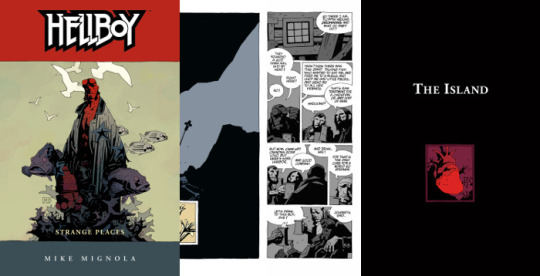
Strange Places: The Island
Words & Art: Mike Mignola | Colours: Dave Stewart | Letters: Clem Robins
Originally published by Dark Horse in Hellboy: The Island #1 & 2 | June & July 2005
Epilogue - Originally published by Dark Horse in Hellboy - Volume 6: Strange Places | April 2006
Collected in Hellboy - Volume 6: Strange Places | Hellboy Library Edition - Volume 3 | Hellboy Omnibus Volume 2: Strange Places
Plot Summary:
Hellboy emerges from the depths of the ocean to a crag of wrecked ships and navigates an island of ghosts, ruminating on who he is, who he was, and who he’s meant to be.
Reading Notes:
(Note: Pagination does not represent anything within the issue or collections themselves, it is solely in reference to the chapter.)

pg. 1 - The bleakness in these panels from the white skies, white water, the faded colour to the gulls and the ships, this feels like purgatory. In his introduction to this story, Mike Mignola said that he was inspired by William Hope Hodgson’s Sargasso Sea stories, which explains the setting, but this feels so much further removed from the world. That Hellboy has landed himself in a no man’s land.
Also, I think a potential interpretation of “The Third Wish” and “The Island” is to see them as two parts of the death and resurrection of Hellboy. Maybe not literally, maybe so, since everything here seems to be an existential exercise. In the former, you could see Hellboy going to a “hell” in the underworld of the sea and the final panels are vague enough that he could have drowned. Then in “The Island”, his soul is traversing this kind of purgatory, facing his demons and angels, while searching for a way to exist again.

pg. 3 - Absolutely stunning work from Mignola and Dave Stewart. The fading, distant sunset just adding to the feeling that wherever Hellboy is, there’s soon to be no light or warmth.

pg. 4 - This is a nice summary of the last story. The appearance of others is certainly strange.
pg. 5-6 - The sea shanty, what’s actually looking more like flaming mugs than just sloshing ale, and weird orange colour definitely give it a feel that something’s wrong here.

pg. 7 - And there’s the rub. You do wonder, though, if Hellboy’s drinking with ghosts or if his loneliness and drink have him hallucinating happier surroundings.
Also, I just love the presentation here. The layout for the page and bottom tier’s grid is just interesting.
pg. 8 - Hecate’s looking a bit different from her last appearance, but it’s interesting to see her here to lay claim on Hellboy. The moon in the background is a nice little hint to her identity, if anyone was confused at the onset before she’s explicitly named.

Also, like the monkey with a gun panel, this is probably one of the funniest sequences in a Hellboy comic.
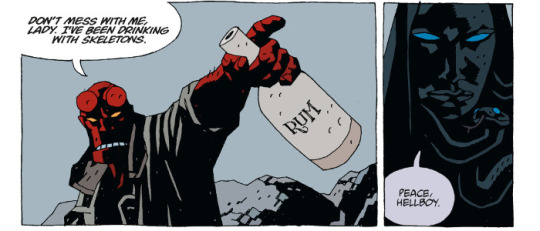
pg. 9-11 - Hecate’s reasoning for Hellboy to join her is kind of weird, reiterating a binary choice that Hellboy himself has rejected the notion of before.
That’s also probably one of the creepiest, most terrifying “I want you inside of me” propositions from a woman...or iron maiden. Somebody should probably do a study of the sexual innuendo in Hellboy and how awkward and strange much of it happens to be.

pg. 11 - Hellboy atop the cliff, tossing away the rum bottle, discovery of another skeleton, and then fade to black is probably one of the scenes in this story that most reminds me of The Seventh Seal.
pg. 12 - And then things possibly get stranger. Being unfixed in time and place give you a lack of orientation literally, so the appearance of a castle randomly on this island is even an odder prospect.

pg. 13 - When has Hellboy ever done the “sane” thing?
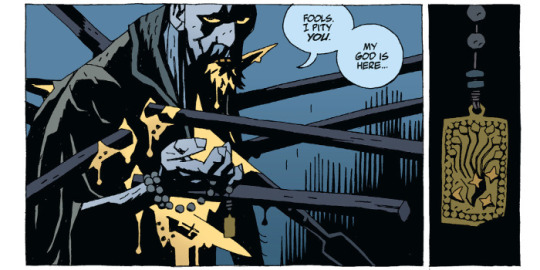
pg. 14-15 - Like the castle, the appearance of the priest, knights, and the man they’re judging as a heretic is hard to place, unexplained, making you wonder if it’s something currently happening, something that has happened previously and we’re just getting a flashback, or what.

pg. 18 - Sudden monster appearance is sudden.
pg. 19-21 - Impressive battle, though there’s an interesting level of futility that Mignola introduces through referencing Moby Dick. That Hellboy is losing himself in continuing this battle.

pg. 22 - Yeah...grievous impalement probably isn’t good.
pg. 24-25 - I definitely seems more now that the bit with the priest is in the past. With the heretic telling the priest that he’ll rise again some time in the future.
pg. 26-27 - The juxtaposition of the heretic’s words in the past over the events in the present with Hellboy are well done. The art as well is just phenomenal. The darkness, the spot colours of red, the designs for the sculptures and decorations, the resuscitation of the old heart, you kind of just have to stare at these pages a few times to take it all in.

pg. 28 - Aside from just looking cool, there are also possibly some hints as to some of the story elements in what otherwise may just seem like random images.

pg. 30 - Mohlomi’s reappearance is certainly interesting. Especially serving as a kind of psychopomp for Hellboy. It makes you wonder if his role even in “The Third Wish” was merely a passive guide, ferrying Hellboy from one place to another.
pg. 31 - I absolutely love that the heretic has taken Hellboy’s colour scheme, along with his blood. It helps reinforce the idea that this is an assumption of Hellboy’s life and destiny, that he’s basically stolen everything of Hellboy’s existence to spur his own resurrection. And in doing so, Hellboy’s colour has faded and left him grey.
There’s also a visual similarity to the wound pattern and silhouette of Rasputin. From a conceptual standpoint, it sets up Hellboy against not just someone who has taken on his essential life spark to serve as a kind of doppelganger, but also a representation of his opposite.

pg. 32 - The heretic basically explaining it to us, and Hellboy just not having any of it is typical. Absolutely gorgeous art still from Mignola and Stewart.
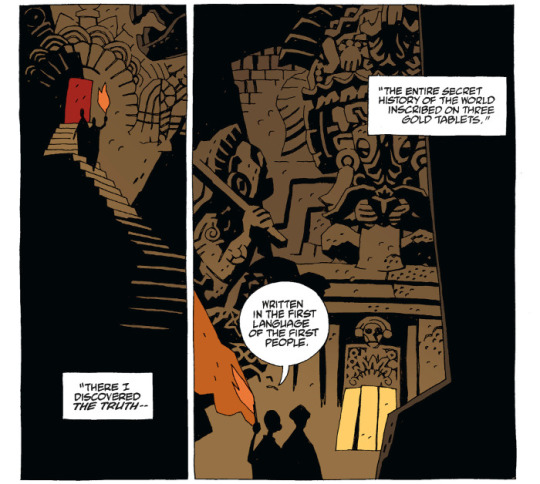
pg. 34 - The legend of those gold tablets (alternately copper in some tellings, I think, but mostly gold) is real. Again, it’s a testament to how Mignola tells a story, weaving in bits of pre-existing folklore, urban legends, mythology, occult, and magick with his own inventions to tell a bigger story.
pg. 37 - I find it very interesting that as soon as Mignola goes into the creation story for Hellboy, the constrained layouts and grids ends. Suddenly we get a full bleed page, something we’ve not seen often in the series. Visually, it signifies that something bigger is being told here, even if you don’t necessarily comprehend that on a first reading.

pg. 39-40 - And that full-page storytelling continues through with the creation of the Ogdru Jahad and their offspring.
pg. 41 - And just weird happenings regarding the creator race of Watchers and the one who basically constructed their “devil” in Ogdru Jahad, and how his bits and pieces ultimately come down to Hellboy’s conception.
pg. 42 - This conception of the creation of gods and monsters, of mice and men, is interesting. Even if predicated on a faulty understanding from Blavatsky.
pg. 44 - Just stunning use of colour from Stewart.

pg. 46 - And it gets woven back into the narrative that started in Seed of Destruction and is currently running through this narrative movement in BPRD.
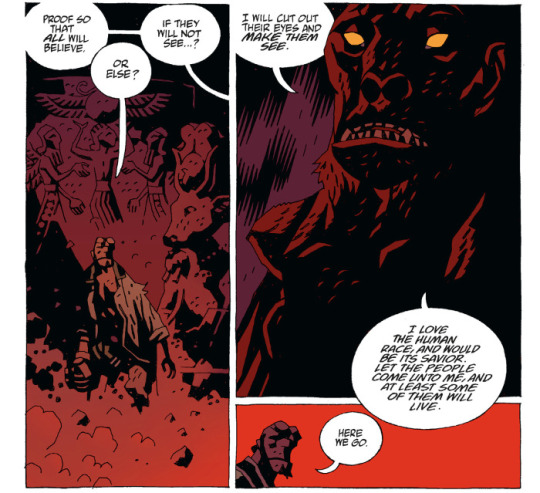
pg. 47 - It’s interesting that it always cycles back to the crazy. Delusions of grandeur and an attempt to run the world, to have it accept him as a saviour, anyone who disagrees be damned. It’s an interesting counterpoint to Hellboy, who doesn’t want to be a hero but tends to do the right thing just because it’s “right”.

pg. 50 - I love it when Hellboy provides his own sound effects.

pg. 51 - It always sucks when hurting the villain hurts you yourself. This mirror nature between the heretic and Hellboy is fascinating. It’s also interesting to see what effect Mohlomi’s trinkets are having.
pg. 52 - The heretic’s assumption of Hellboy’s “true” form, even as this nascent Anung Um Rama demon--though looking a wee bit more like Astaroth--is interesting. It’s a sign of a path not taken.
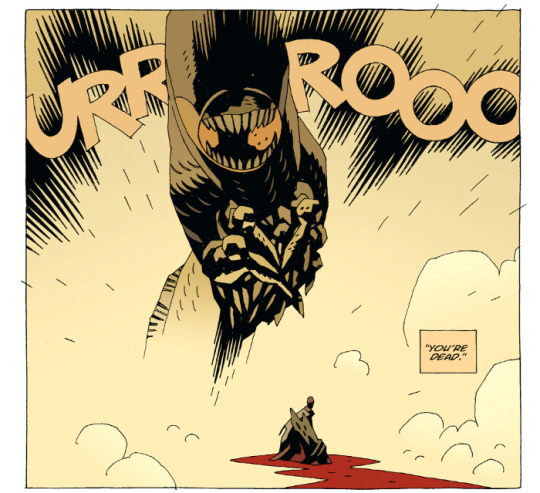
pg. 53 - Creepy worm is back.

pg. 54 - The heretic suffering as the worm creature thing dies is an interesting touch. Gorgeous artwork.

pg. 56 - After all that...

pg. 57 - Ominous hint of things to come.

pg. 60 - Love the use of the fairies and night creatures and whatnot again as a kind of Greek chorus for the epilogue.
Also a hint for what comes next in the main narrative, “Even now he is bound for England.” which I think picks up in Darkness Calls.
pg. 61 - I find it interesting that Hecate has apparently fallen silent, likely living by Hellboy’s wish for her to leave him alone (at least for the time being).
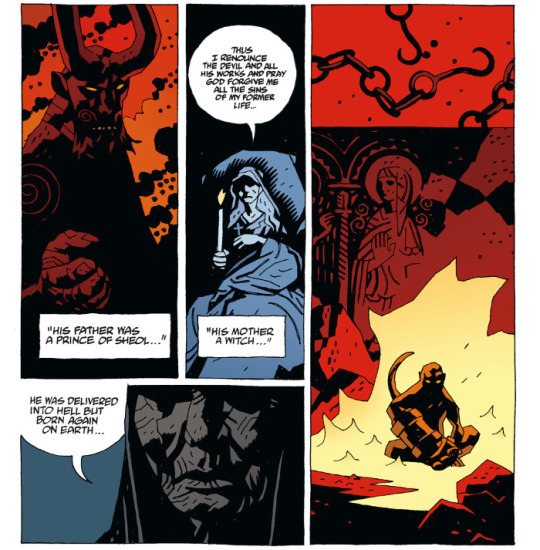
pg. 62-63 - Nice reiteration and reinterpretation of who Hellboy is.
pg. 63 - It’s also interesting as to just how much of Hellboy’s eventual fate is shaped just because this little hobgoblin, Gruagach, couldn’t handle his smackdown from being a jerk back in “The Corpse”.
pg. 65 - Just let it go, pig dude.
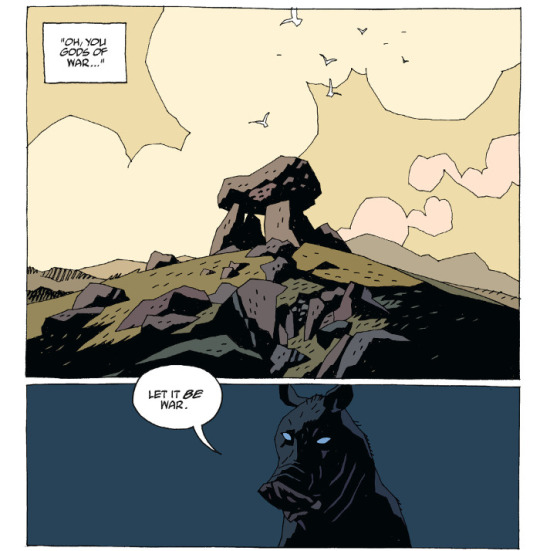
Final Thoughts:
So...if “The Third Wish” was a fairy tale, Mike Mignola’s tragic take on Hans Christian Andersen’s The Little Mermaid, this is something else entirely as a follow-up, somewhere between The Seventh Seal and Black Narcissus. It’s bleak, distant, esoteric, and absolutely lush when it comes to its use of colour to set mood and atmosphere.
While it is a resumption of the origin cycle for Hellboy that has played out before in the narrative a few times now since Seed of Destruction, it’s also a bit of transference and confrontation of Hellboy’s destiny that plays out here. Where previous iterations may have been an emotional response and rejection, here we get a more measured physical and intellectual rejection.
This also feels kind of like a dry run for the storytelling approach that we’re going to eventually be seeing in parts of Hellboy in Hell. This story definitely takes us to some strange places.

d. emerson eddy is just a broken machine, with all the layers of dust some things have started to fail. Some things. Some.
2 notes
·
View notes